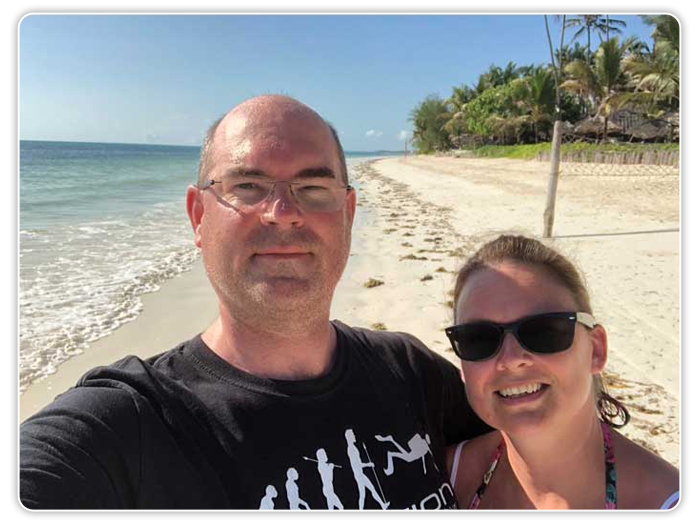Mistake Costs Entrepreneur $300,000
Heads Up! There are several juicy entrepreneurial lessons here for you to find – I point some out but see if you can spot the rest.
31 year old Sabeena Ladha launched her vegan cookie dough company in June 2020.
Lesson #1: Just because there’s stuff happening (a global pandemic, for example) doesn’t mean you can’t get stuff done.
She named her company Deux, which is pronounced “dough”, which I find irritating as heck, but that’s just me.
By the time Sabeena went on Shark Tank to ask for $300,000, she’d already raised $1 million in venture capital and brought in $630,000 in revenue.
Lesson #2: Think big and move fast because… why not? Who says you have to slog away for years before creating your success?
She uses a direct to consumer Instagram sales strategy with placement in 40 Whole Foods locations.
Lesson #3: Combine online with offline tactics for maximum effect.
One of the Sharks, Robert Herjavec, noted that he didn’t like sweets but wanted to invest in her rather than the company. He offered Ladha $300,000 for 15% of her company’s equity.
Ladha then went on to haggle over the specifics of the deal, causing Herjavec to pull out.
Now I know the author of this article (link below) states this was a mistake, and perhaps it was. Billions of dollars of sales have been lost because the person doing the selling didn’t know when to stop talking.
However, I’m going to give Ladha the benefit of the doubt here, which brings us to…
Lesson #4: Know what you want and don’t give away the farm to get it.
I think Ladha didn’t want to give 15% of her company away, which is why she was haggling over terms. To her it was more important to retain as much ownership as possible rather than raise more money. (Remember she already had $1 million in venture capital and $600,000 in sales.)
However…
There is more to this story than just money. Herjavec is a seasoned entrepreneur who could have guided Ladha to even greater success. It’s possible that giving away the 15% of equity would have eventually put millions into her pocket she otherwise would not have earned, but we’ll never know.
And finally, the entire point of this story is that Ladha failed to read the room. These Sharks aren’t kids. They’re older, they’re concerned for their health, and they found Ladha’s 110 calories per 28 grams of cookie dough spread to be well outside of their health-conscious comfort zone.
When one of the investors told Ladha that he no longer eats this kind of food, she defended her product by saying he was not her target consumer.
“I am the target investor,” he retorted.
Ouch.
Lesson #5: Find ways to make people feel good about themselves rather than marginalizing them or making them feel (in this case) old.
Read the room, whether it’s in person or online, and speak to your prospects in a way that respects them and makes them feel better than before you got there, and you’ll be halfway to making the sale.
I just went to Ladha’s website https://www.eatdeux.com and encountered (GASP!) a pop-up asking for my email address.
Smart.
But what surprised me was how it was worded:
“Sign Up for 10% Off”
“We’ll Send Sweet AF Emails”
Now unless “AF” means something other than what I’m thinking… geez. You can tell she is marketing to a young demographic and not to Grandma and Grandpa.
Lesson #6: Know your audience and how they like to communicate.
I entered my email address, hit submit and got… an error message. Not kidding. I tried it twice.
Lesson #7: Regularly check every aspect of your website to see if it’s working.
Are we done yet?
Not quite.
Here’s the best lesson of all:
Lesson #8: Handle product objections BEFORE they kill sales.
This is a high calorie product. Of course, they could simply avoid that topic altogether and hope people don’t notice.
But with everyone on social media having an opinion, that likely won’t work.
Instead, they made an entire slideshow demonstrating why their calorie count is a GOOD thing.
Here’s the gist of the slideshow:
Slide 1:
“This is too high calorie.” (A thread about why this narrative is so f*cked.)
Slide 2:
Nutrition Facts (Looks kind of like a nutritional label)
High Calorie ≠ Unhealthy
Quality > Quantity
Calorie counting = big impact on mental health + small impact on long term physical health.
Slide 3:
Not all calories are created equal. Let’s compare two chocolate chip cookies.
Here they compare their cookie to Nestle Tollhouse, showing calories and ingredients.
Slide 4:
The quick math:
Calories in one serving of a:
Nestle Tollhouse Cookie = 90
DEUX Cookie = 110
Choose the lower calorie cookie? You’ve given up 20 calories but you’re consuming 11 extra (quietionable) ingredients.
Choose the higher calorie cookie? Sure, that’s an extra 20 calories. But those extra 20 calories are whole, clean ingredients that fuel your body. Because that’s what calories are for, right?
Slide 5:
Oh, and a quick English lesson:
The word “calorie” is just another word for energy. I’m serious. Look it up.
Slide 6:
TL;DR*
Eat whatever the f*ck you want. (Sometimes I pick the Nestle cookie, too!) But don’t be scared of something because it’s “high calorie.”
“High calorie” does not make something less healthy and “high calorie” should never deter you from eating things that fuel your body (like oats and nut butters)!
Eat what makes you feel good. And also f*ck restrictive diet culture.
Bye now!
You’ll notice she takes the “high calorie” objection and turns it on its head, making a negative into a benefit.
How can you apply that in your business?
One last thing…
Lesson #9: “I’m just like you”. Notice how she says she eats Nestle Tollhouse cookies, too?
People buy from brands and people they like. And people like brands and people who are just like them (or at least they perceive them as being just like them.)
What do you and your customers have in common? Point it out to build camaraderie and make sales, because this stuff works.
*Are you wondering what TL;DR means?
Don’t feel bad. This internet abbreviation stuff is like an entirely new language.
TL;DR means, “Too long, didn’t read.” If someone didn’t read the previous slides, they can read the TL;DR for a short summary of the post.
For example, the TL;DR of Romeo and Juliet might be, “A 6 day relationship between a 17 year old and a 13 year old causes 5 deaths.”
There. Now I saved you from having to read the play. 😉
What This Guy Stumbled Across By Accident Nearly TWENTY YEARS AGO Is Anything But Average.

It's Still Banking Him $25,000 - $35,000 EVERY SINGLE MONTH!
Privacy Policy: We value your privacy. You can unsubscribe from receiving future emails with 1 click at any time.

















